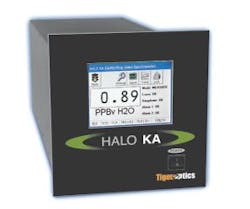Tiger Optics laser-based analyzer performs continuous-wave cavity ringdown spectroscopy
The HALO-KA high-purity analyzer provides a detection limit of 500 ppt H2O in nitrogen (200 ppt in helium). Two of the compact new instruments will fit in a 19 in rack. Patented continuous-wave cavity ringdown spectroscopy (CW CRDS) requires no moving parts or calibration. It is designed to detect traces of contaminants in an ultrahigh-purity (UHP) gas stream.
Tiger Optics
San Francisco, CA
[email protected]
-----
PRESS RELEASE
TIGER OPTICS INTRODUCES THE HALO-KATM ANALYZER
COMPACT DEVICE ACHIEVES ULTRA-LOW DETECTION LIMITS AT A COMPELLING PRICE
San Francisco, CA – Caught between shrinking margins and shrinking geometries, today’s semiconductor fabricators and their suppliers have reason to rejoice, at least when it comes to gas analysis.
Tiger Optics LLC, known for its innovative laser-based analyzers, is unveiling an affordable new tool that can detect traces of contaminants to 200 parts-per-trillion levels in an ultra-high-purity (UHP) gas stream.
Not just small in price, the powerful HALO-KATM features the smallest footprint of any high-purity analyzer in the market, thereby providing additional savings. Indeed, with a low detection limit of 500 ppt H2O in nitrogen (200 ppt in helium), two of the new instruments will fit in a 19-inch rack. Moreover, its powerful, patented principle of operation, Continuous Wave Cavity Ring-Down Spectroscopy (CW CRDS), requires no moving parts or calibration, thus saving on down-time, labor, and consumables. With such environmentally friendly features, the HALO-KA offers another advantage to fabs concerned with their overall carbon footprint.
The HALO-KA is the latest addition to a platform that debuted in 2006 as the HALO, a “mini” device measuring moisture in a range from 2 ppb to 20 ppm, offering the speed, specificity and reliability of the original Tiger tools at approximately half the price and one-quarter the size. Notably, the original HALO was conceptualized by Dr. Farhang Shadman, the respected director of the NSF/SRC Engineering Research Center for Environmentally Benign Semiconductor Manufacturing at the University of Arizona.
The HALO+ analyzer, introduced at Semicon West in 2007, provided detection limits down to 400 ppt to customers in fields as diverse as gas manufacturing, semiconductor fabrication, and national metrology institutes. When a customer requested an analyzer with an extended upper detection limit, Tiger Optics answered in 2010 with the HALO-500-H2O, which provides the widest detection range of any Tiger product.
“Our newest HALO is unique in its ability, as an all-in-one device, to monitor extremely low levels of contamination in a UHP gas stream,” said Lisa Bergson, Tiger Optics’ founder and chief executive. “Not only can the HALO-KA monitor moisture, but we also have systems available to monitor a wide variety of analytes in both inert and corrosive gases.”
About Tiger Optics
Tiger Optics, LLC makes powerful, laser-based gas analyzers that help manufacturers achieve faster throughput, with less waste. Some 1,500 robust Tiger units are at work in such demanding environments as semiconductor fabrication plants, gas manufacturers, chemical companies, and the metrology institutes of 16 nations. For additional information, visit www.tigeroptics.com.
-----
Subscribe now to Laser Focus World magazine; it's free!
